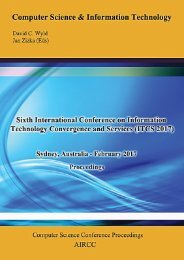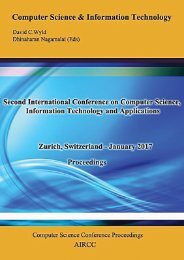CoSIT 2017
Fourth International Conference on Computer Science and Information Technology ( CoSIT 2017 ), Geneva, Switzerland - March 2017
Fourth International Conference on Computer Science and Information Technology ( CoSIT 2017 ), Geneva, Switzerland - March 2017
Create successful ePaper yourself
Turn your PDF publications into a flip-book with our unique Google optimized e-Paper software.
Computer Science & Information Technology (CS & IT) 107<br />
{ 2 n1-1 – 1, 2 n1-1 + 1, 2 n2 - 1 – 1, 2 n2 - 1 + 1, …, 2 nN- 1 – 1, 2 nN- 1 + 1 }.<br />
The proposed Non-coprime multi-moduli set form is :<br />
S = { 2 n1 – 2, 2 n1 + 2, 2 n2 – 2, 2 n2 + 2, …, 2 nN – 2, 2 nN + 2 }.<br />
It is clear that each conjugate-pair on the numbers line is 4 spaces apart. As discussed in [2] it was<br />
shown that having the shape of the new non-coprime moduli set ( i.e. { 2 n – 2, 2 n , 2 n + 2 } )<br />
being 4 spaces apart from each other helped in the Forward conversion process (FC) of the<br />
moduli. The same space for our new non-coprime multi-moduli is useful indeed.<br />
Lets take an example to show what is meant by the spaces above.<br />
Ex. 1 Let n1 = 3 , n2 = 4 for the set S.<br />
Then the set S = { 6, 10, 14, 18 }.<br />
Numbers ( 6 , 10 ) and ( 14 , 18 ) are 4 spaces from each other on the numbers line. This is true<br />
for any value taken for { n1, n2 … , nN }, notice that n1 < n2 < … < nN ; n1 >= 2.<br />
This is need for the management process to prepare the multi-moduli in good shape.<br />
Least Common Multiple (LCM) is must be used for the non-coprime case, since there is a<br />
common factor among the modulus numbers.<br />
3. NEW NON-COPRIME MULTI-MODULI PROPOSED FORWARD<br />
CONVERTER<br />
This section is preferred to be divided into two sections in order to show simply how it works.<br />
Then from the multi-moduli shape provided it is generalized for size of (N).<br />
In the first section, we are going to take N = 2, thus the multi-moduli would consist of 4 modulus<br />
values. The second sub-section we are having N = 3, so there would be 6 modulus inside the<br />
multi-moduli set. Forward conversion ( i.e. Binary to RNS ) is to be implemented for each case.<br />
3.1 VALUES SET OF 4-MODULUS<br />
The multi-moduli set will be of the form, when we take N = 2 :<br />
S = { 2 n1 – 2, 2 n1 + 2, 2 n2 – 2, 2 n2 + 2 }.<br />
If we take as the first example showed n1 = 3 , n2 = 4 . The shape of the set was :<br />
S1 = { 6, 10, 14, 18 }.<br />
M ( i.e. Dynamic Range of the set ) is calculated through the LCM. For the set S1 it is equal to





